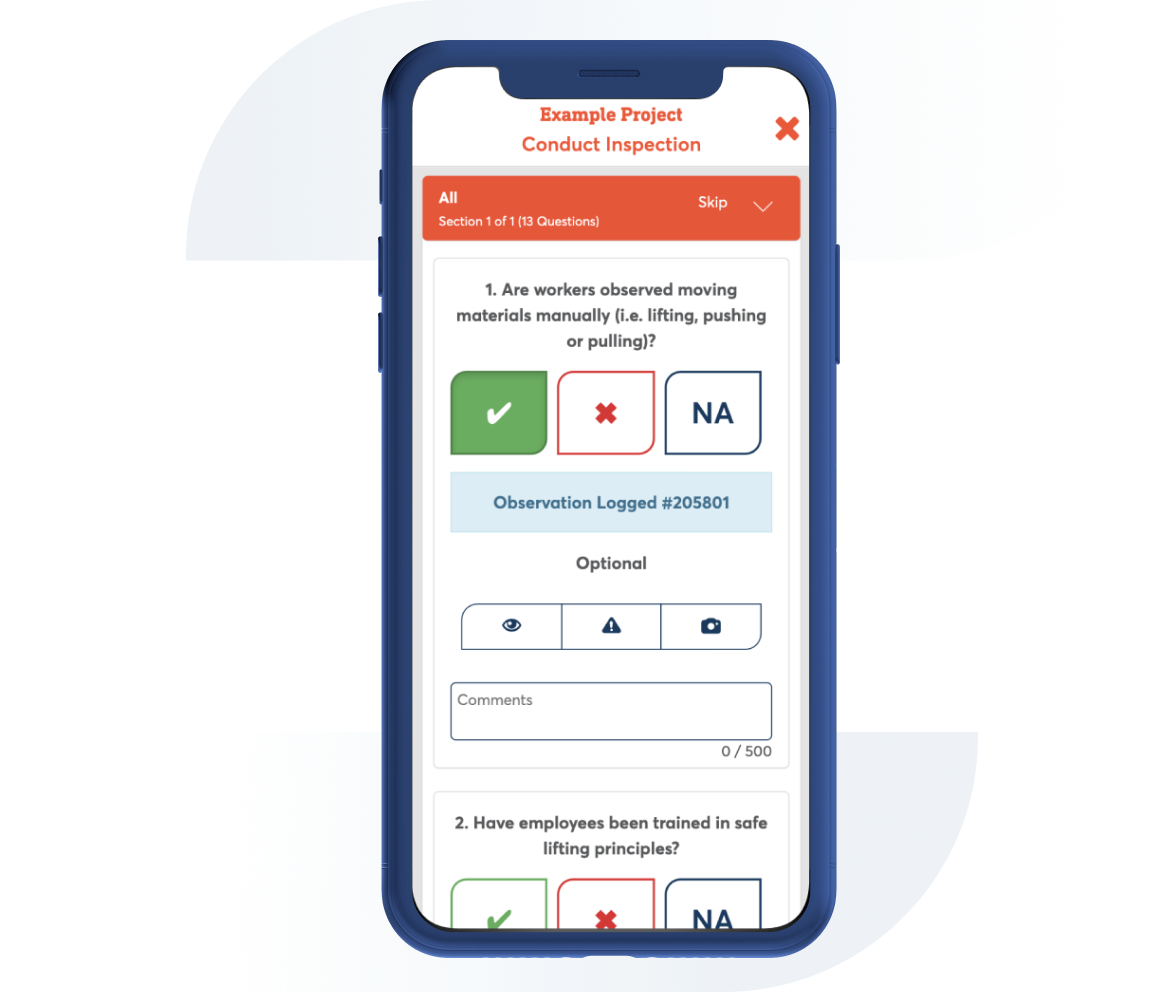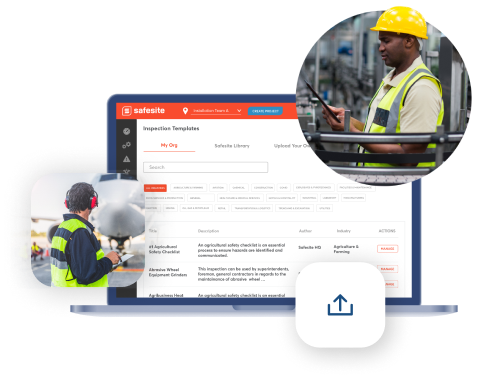OSHA Fixed Ladders Inspection
Contributor: Safesite Jurisdiction: USA OSHA
When using fixed ladders in the workplace, refer to this OSHA inspection to meet all necessary requirements for length, weight threshold and proper safety device and support system installation.

Template Preview
1. Fixed Ladders: If the total length of the climb on a fixed ladder equals or exceeds 24 feet (7.3 m), the lad- der must be equipped with ladder safety devices; or self-retracting lifelines and rest platforms at intervals not to exceed 150 feet (45.7 m); or a cage or well and multiple ladder sections with each ladder section not to exceed 50 feet (15.2 m) in length. These ladder sections must be offset from adjacent sections and landing platforms must be provided at maximum intervals of 50 feet (15.2 m).
Actions
2. Fixed Ladders: In addition, fixed ladders must meet the following requirements: Fixed ladders must be able to support at least two loads of 250 pounds (114 kg) each, concentrated between any two consecutive attachments. Fixed ladders also must support added anticipated loads caused by ice buildup, winds, rigging and impact loads resulting from using ladder safety devices.
Actions
3. Fixed Ladders: In addition, fixed ladders must meet the following requirements: Individual rung/step ladders must extend at least 42 inches (1.1 m) above an access level or landing platform either by the continuation of the rung spacings as horizontal grab bars or by providing vertical grab bars that must have the same lateral spacing as the vertical legs of the ladder rails. Each step or rung of a fixed ladder must be able to support a load of at least 250 pounds (114 kg) applied in the middle of the step or rung.
Actions
4. Fixed Ladders: In addition, fixed ladders must meet the following requirements: Minimum clear distance between the sides of individual rung/step ladders and between the side rails of other fixed ladders must be 16 inches (41 cm). Rungs of individual rung/step ladders must be shaped to prevent slipping off the end of the rungs. Rungs and steps of fixed metal ladders manufactured after March 15, 1991, must be corrugated, knurled, dimpled, coated with skid-resistant material or treated to minimize slipping. Minimum perpendicular clearance between fixed ladder rungs, cleats, and steps and any obstruction behind the ladder must be 7 inches (18 cm), except that the clearance for an eleva- tor pit ladder must be 4.5 inches (11 cm). Minimum perpendicular clearance between the centerline of fixed ladder rungs, cleats and steps, and any obstruction on the climbing side of the ladder must be 30 inches (76 cm). If obstructions are unavoidable, clearance may be reduced to 24 inches (61 cm), provided a deflection device is installed to guide workers around the obstruction.
Actions
5. Fixed Ladders: In addition, fixed ladders must meet the following requirements: Step-across distance between the center of the steps or rungs of fixed ladders and the nearest edge of a landing area must be no less than 7 inches (18 cm) and no more than 12 inches (30 cm). A landing platform must be provided if the step-across distance exceeds 12 inches (30 cm).
Actions
6. Fixed Ladders: In addition, fixed ladders must meet the following requirements: Fixed ladders without cages or wells must have at least a 15-inch (38 cm) clearance width to the nearest permanent object on each side of the centerline of the ladder. Fixed ladders must be provided with cages, wells, ladder safety devices or self-retracting lifelines where the length of climb is less than 24 feet (7.3 m) but the top of the ladder is at a distance greater than 24 feet (7.3 m) above lower levels.
Actions
7. Fixed Ladders: In addition, fixed ladders must meet the following requirements: Side rails of through or side-step fixed ladders must extend 42 inches (1.1 m) above the top level or landing platform served by the ladder. Parapet ladders must have an access level at the roof if the parapet is cut to permit passage through it. If the parapet is continuous, the access level is the top of the parapet.
Actions
8. Fixed Ladders: In addition, fixed ladders must meet the following requirements: Steps or rungs for through-fixed-ladder exten- sions must be omitted from the extension; and the extension of side rails must be flared to provide between 24 inches (61 cm) and 30 inches (76 cm) clearance between side rails.
Actions
9. Fixed Ladders: In addition, fixed ladders must meet the following requirements: When safety devices are provided, the maxi- mum clearance distance between side rail extensions must not exceed 36 inches (91 cm). Fixed ladders must be used at a pitch no greater than 90 degrees from the horizontal, measured from the back side of the ladder.
Actions
10. Cages for Fixed Ladders: The requirements for cages for fixed ladders are as follows: Horizontal bands must be fastened to the side rails of rail ladders or directly to the structure, building or equipment for individual-rung ladders. Vertical bars must be on the inside of the horizontal bands and must be fastened to them. Cages must not extend less than 27 inches (68 cm), or more than 30 inches (76 cm) from the centerline of the step or rung and must not be less than 27 inches (68 cm) wide. Insides of cages must be clear of projections. Horizontal bands must be spaced at intervals not more than 4 feet (1.2 m) apart measured from centerline to centerline. Vertical bars must be spaced at intervals not more than 9.5 inches (24 cm), measured centerline to centerline. Bottoms of cages must be between 7 feet (2.1 m) and 8 feet (2.4 m) above the point of access to the bottom of the ladder. The bottom of the cage must be flared not less than 4 inch- es (10 cm) between the bottom horizontal band and the next higher band. Tops of cages must be a minimum of 42 inches (1.1 m) above the top of the platform or the point of access at the top of the ladder. There must be a way to access the platform or other point of access.
Actions
11. Wells for Fixed Ladders: The requirements for wells for fixed ladders are as follows: Wells must completely encircle the ladder. Wells must be free of projections. Inside faces of wells on the climbing side of the ladder must extend between 27 inches (68 cm) and 30 inches (76 cm) from the center- line of the step or rung. Bottoms of wells above the point of access to the bottom of the ladder must be between 7 feet (2.1 m) and 8 feet (2.4 m).
Actions
12. Ladder Safety Devices and Related Support Systems for Fixed Ladders: The connection between the carrier or lifeline and the point of attachment to the body belt or harness must not exceed 9 inches (23 cm) in length. In addition, ladder safety devices and related support systems on fixed ladders must conform to the following: All safety devices must be able to withstand, without failure, a drop test consisting of a 500-pound weight (226 kg) dropping 18 inches (41 cm).
Actions
13. Ladder Safety Devices and Related Support Systems for Fixed Ladders: In addition, ladder safety devices and related support systems on fixed ladders must conform to the following: All safety devices must permit the worker to ascend or descend without continually having to hold, push or pull any part of the device, leaving both hands free for climbing. All safety devices must be activated within 2 feet (.61 m) after a fall occurs and limit the descending velocity of an employee to 7 feet/second (2.1 m/sec) or less.
Actions
14. Requirements for Mounting Ladder Safety Devices for Fixed Ladders: The requirements for mounting ladder safety devices for fixed ladders are as follows: Mountings for rigid carriers must be attached at each end of the carrier, with intermediate mountings spaced along the entire length of the carrier, to provide the necessary strength to stop workers’ falls. Mountings for flexible carriers must be attached at each end of the carrier. Cable guides for flexible carriers must be installed with a spacing between 25 feet (7.6 m) and 40 feet (12.2 m) along the entire length of the car- rier, to prevent wind damage to the system. Design and installation of mountings and cable guides must not reduce the strength of the ladder.
Actions
15. Requirements for Mounting Ladder Safety Devices for Fixed Ladders: The requirements for mounting ladder safety devices for fixed ladders are as follows: Side rails and steps or rungs for side-step fixed ladders must be continuous in extension.
Actions
16. Defective Ladders: Ladders needing repairs are subject to the following rules: Portable ladders with structural defects—such as broken or missing rungs, cleats or steps, broken or split rails, corroded components or other faulty or defective components—must immediately be marked defective or tagged with "Do Not Use" or similar language and withdrawn from service until repaired. Fixed ladders with structural defects—such as broken or missing rungs, cleats or steps, broken or split rails or corroded components— must be withdrawn from service until repaired. Defective fixed ladders are considered with- drawn from use when they are immediately tagged with "Do Not Use" or similar language, or marked in a manner that identifies them as defective, or blocked—such as with a plywood attachment that spans several rungs. Ladder repairs must restore the ladder to a condition meeting its original design criteria before the ladder is returned to use.
Actions
17. Write Comments or Remarks here:

Can't find what you are looking for?
